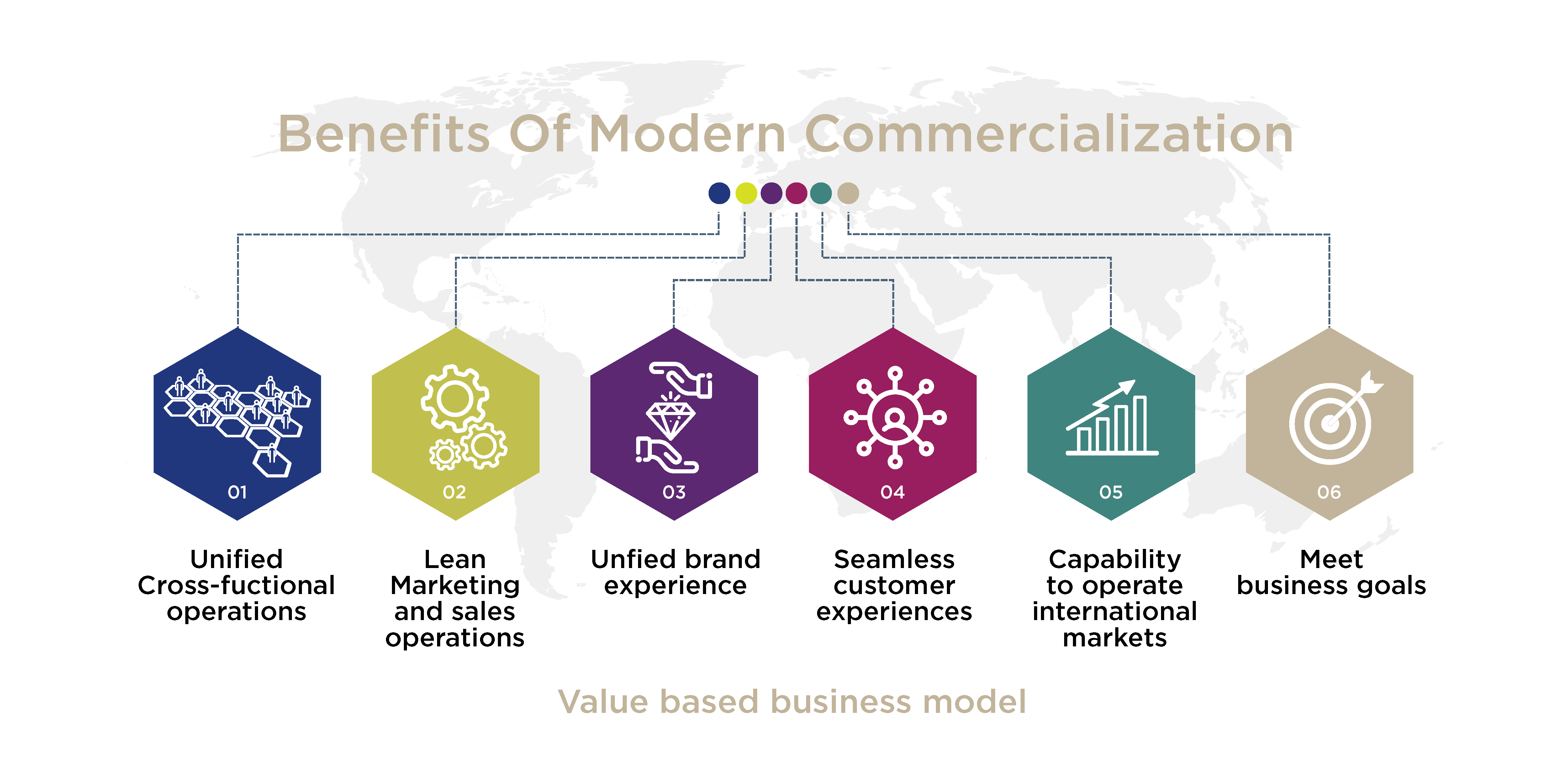
Benefits of Modern Commercialization
Modern commercialization creates value for organizations and their customers and end-customers by combining an omnichannel strategy with a systematic, systemic, and lean approach.
Commercialization and go-to-market have changed dramatically during the past years because of technological and communication innovations as customer behavior in all segments B2B, B2C, and D2C.
The new norm is the expectation of a unified and seamless brand and customer (service) experience during the purchase journey.
This new norm challenges brand marketers and manufacturers to think about commercialization in a modern way to succeed in the international markets.
Therefore, an omnichannel business strategy and tactics are the modern approach to enable customers to obtain a wider choice of products and allow companies to generate more revenue, increase efficiency, and reduce costs.

#01 Unified Cross-Functional Operations
Unified cross-functional operations refer to a business approach that integrates different functions within an organization to work together towards business goals. Departments of an organization that traditionally operate independently, such as marketing, sales, operations, and finance, work collaboratively to achieve a shared objective.
The benefits of unified cross-functional operations are numerous. It enhances communication and coordination among departments, minimizes duplication of effort, and encourages a holistic approach to problem-solving. It also allows for the efficient allocation of resources, reduces decision-making time, and improves overall organizational effectiveness.
#02 Lean Marketing and Sales Operations
Lean Marketing and Sales Operations is a business strategy that emphasizes streamlining the processes and reducing waste related to the company’s marketing and sales operations. The goal is to increase efficiency, improve customer satisfaction, and reduce costs.
To implement Lean Marketing and Sales Operations, companies need to follow a few central principles:
- Value-based marketing
- Continuous improvement
- Data-driven decision making
- Collaboration common goals
- Customer-centric approach
#03 Unfied Brand Experience
A unified brand experience means the company presents a consistent and cohesive message and service experience across all touchpoints and channels a customer may interact with a brand. It means that the brand voice, values, personality, and visual identity are consistent, regardless of where the customer encounters the brand, including everything from the company’s website, social media channels, advertising, product packaging, and in-space (e.g., store, office, cafe) experience.
A unified brand experience is essential for building brand trust, loyalty, and recognition. When a customer has a positive experience with a brand, they are more likely to remember it and recommend it to others. A unified brand experience also helps to create a sense of brand identity, which can be a powerful tool for differentiation in a crowded marketplace.
To achieve a unified brand experience, companies need to:
- Define their brand identity
- Develop a customer-centric approach
- Train employees
- Monitor brand consistency
#04 Seamless Customer experience
A seamless customer experience is an approach where companies aim to provide a consistent and integrated customer journey across all touchpoints and channels. It means that a customer can smoothly move from one touchpoint to another – such as, from a website to a mobile app or from an online store to a physical store, without disruption or confusion.
A seamless customer experience is essential for building brand loyalty and trust. Positive experiences with a company are more likely to affect a return customer and recommend the company to others.
A seamless customer experience also helps to create a sense of brand identity, which can be a powerful tool for differentiation in a crowded marketplace.
To achieve a seamless customer experience, companies need to:
- Map out the customer journey
- Integrate all touchpoints
- Simplify the customer journey
- Use customer data
- Train employees
#05 Capability to Operate International Markets
Having omnichannel capability can be a significant advantage for companies operating in international markets.
Omnichannel capability refers to the ability of a company to provide a seamless and integrated experience across multiple channels, including digital and physical touchpoints.
Here are a few ways that omnichannel capability can help companies operate in international markets:
- Provide a expected and consistent brand experience
- Provide a expected and consistent customer (service) experience
- Adapt to local markets
- Reach more customers
- Efficient supply chain management
- Cross-border payments
By leveraging omnichannel capabilities, companies can improve their ability to operate in international markets and provide a better customer experience, which can help to drive growth and increase revenue.
It is essential to note that implementing omnichannel capabilities requires investment in technology and infrastructure, as well as a deep understanding of local markets and customer preferences.
#06 Meet Business Goals
A modern omnichannel commercialization approach helps a company meet its business goals by leveraging technology and customer data to create a seamless and integrated customer experience across all touchpoints.
Here are some central steps that companies can take to implement a modern omnichannel commercialization approach
- Develop a deep understanding of the customer journey
- Implement an integrated technology platform
- Consistent brand experience
- Personalize the customer experience
- Optimize for mobile
- Create a seamless personal data and checkout process
- Leverage social media
By implementing a modern omnichannel commercialization approach, companies can improve the customer experience, increase customer loyalty, and drive revenue growth.
